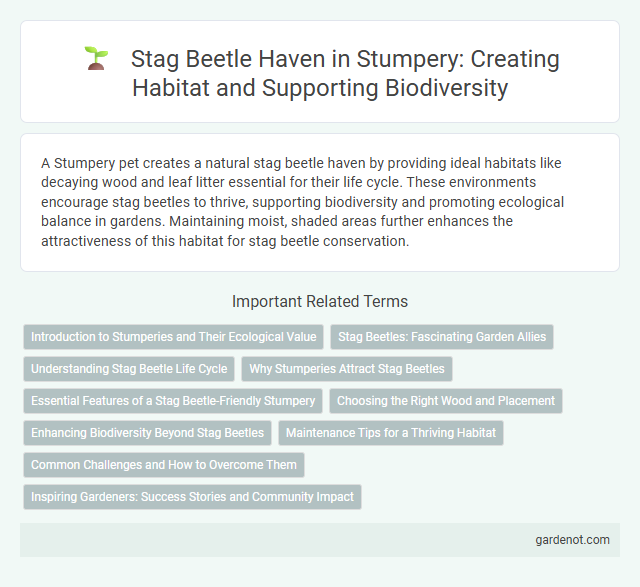A Stumpery pet creates a natural stag beetle haven by providing ideal habitats like decaying wood and leaf litter essential for their life cycle. These environments encourage stag beetles to thrive, supporting biodiversity and promoting ecological balance in gardens. Maintaining moist, shaded areas further enhances the attractiveness of this habitat for stag beetle conservation.
Introduction to Stumperies and Their Ecological Value
Stumperies are naturalistic garden features made from decaying tree stumps and logs, providing essential habitats for stag beetles and other woodland invertebrates. These structures recreate fallen wood environments crucial for the beetle larvae, which rely on rotting wood to develop over several years. By supporting stag beetle populations, stumperies contribute to biodiversity and promote healthy ecosystems in urban and rural settings.
Stag Beetles: Fascinating Garden Allies
Stag beetle havens provide essential habitats that support the lifecycle of Lucanus cervus, Europe's largest beetle species, known for their distinctive mandibles and crucial role in decomposing decaying wood. Creating a stumpery with rotting logs and deadwood encourages stag beetle larvae development, enhancing biodiversity and promoting nutrient recycling in garden ecosystems. These fascinating garden allies contribute to natural pest control and are indicators of healthy woodland environments, making their conservation vital for sustainable gardening.
Understanding Stag Beetle Life Cycle
Stag beetles undergo a complex life cycle starting with eggs laid in decaying wood, where larvae spend up to five years developing by feeding on rotting timber. The larval stage is critical for growth before pupating underground and emerging as adult beetles during late spring to early summer. Creating a stag beetle haven with ample deadwood and undisturbed soil supports each stage of their life cycle, promoting population sustainability.
Why Stumperies Attract Stag Beetles
Stumperies provide ideal habitats for stag beetles by offering abundant decaying wood, which is crucial for their larvae development. The moist, shaded environment within stumperies protects these beetles from predators and harsh weather conditions. Dense woody debris in stumperies also supports the insects' life cycle, enhancing local stag beetle populations.
Essential Features of a Stag Beetle-Friendly Stumpery
A stag beetle-friendly stumpery requires decaying wood, such as old logs and tree stumps, which provides essential breeding and feeding habitats for larvae. Incorporating a variety of shaded, moist microhabitats helps maintain the ideal environment for stag beetle development. Presence of native broadleaf trees nearby enhances biodiversity, supporting the stag beetle's lifecycle with natural resources.
Choosing the Right Wood and Placement
Selecting hardwoods like oak, beech, and ash for a stag beetle haven in a stumpery provides essential nutrients and suitable decay conditions for larvae development. Placing the stumpery in a shaded, humid location near old trees ensures optimal microclimate stability, promoting beetle habitation and protection from predators. Maintaining moisture levels by stacking wood loosely and avoiding direct ground contact enhances larval survival and supports stag beetle life cycles effectively.
Enhancing Biodiversity Beyond Stag Beetles
Creating a stag beetle haven significantly enhances local biodiversity by providing essential habitats for various invertebrates, amphibians, and small mammals beyond just stag beetles. Incorporating decaying wood, leaf litter, and native plants supports a complex ecosystem, promoting nutrient cycling and soil health. This diverse environment fosters resilient populations, increasing ecological balance and conservation value within the stumpery landscape.
Maintenance Tips for a Thriving Habitat
Maintaining a stag beetle haven requires preserving deadwood habitats like rotting logs and tree stumps, essential for larval development and adult shelter. Regularly monitor moisture levels to ensure the environment remains damp but not waterlogged, supporting fungal growth vital for beetle larvae nutrition. Avoid using pesticides or disturbing the habitat during late spring and summer when adults emerge and mate to promote a thriving stag beetle population.
Common Challenges and How to Overcome Them
Stag beetle havens often face challenges such as habitat loss, predation, and climate sensitivity, which can limit population growth. Creating a diverse environment with deadwood, leaf litter, and native plants provides essential shelter and breeding sites, while careful monitoring helps manage predator impact. Enhancing moisture retention through mulch and minimizing pesticide use supports stag beetle survival and encourages natural reproduction.
Inspiring Gardeners: Success Stories and Community Impact
Stag beetle havens have transformed local ecosystems by creating vital habitats that support these rare insects, inspiring gardeners to adopt sustainable practices. Success stories highlight increased stag beetle populations and thriving biodiversity, showcasing how community-driven efforts enhance urban green spaces. Engagement in these projects fosters environmental awareness and strengthens communal bonds through shared conservation goals.
Stag beetle haven Infographic

 gardenot.com
gardenot.com